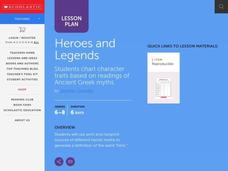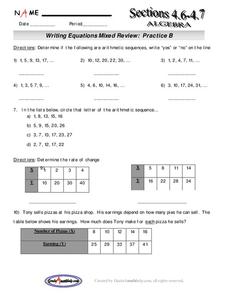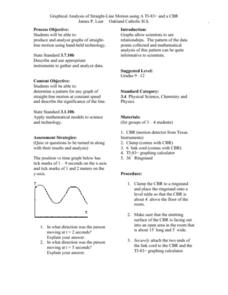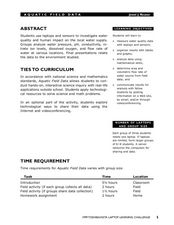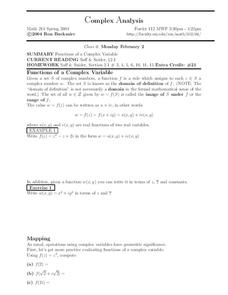Curated OER
Mapping The Ocean Floor
Young scholars explore and analyze the bottom structure of underwater habitats. They describe and explain what can't see through the collection and correlation of accurate data. Learners assess that technology is utilized as a tool for...
Curated OER
Relations and Functions
Students differentiate between a relation and a function. In this algebra lesson, students identify a pair of coordinates as being a relation or a function. They analyze graphs for function as they solve word problems.
Curated OER
Polly and the Shapeshifter
Students analyze the patterns in polygons and relate it to the rate of change. In this algebra lesson, students discuss the relationship between the data and the graph of the data.
Curated OER
CROSSWORD PUZZLE
Students define from a word list for a literary selection. Using the literary selection, they read the vocabulary in context. They determine the definition of the word as used in context and create a crossword puzzle using the...
Curated OER
Heroes and Legends
Young scholars use print and nonprint sources of different heroic myths to generate a definition of the word "hero." They conduct a character study on three mythological heroes and formulate a definition of the word "hero" based on...
Curated OER
Mineral Identification
In this mineral identification lesson plan, learners analyze 14 minerals and test their physical properties. They test the color, luster, streak, hardness and breakage of each mineral. Students answer 5 questions about the physical...
Texas Instruments
Measure Up!
Statisticians take things to new heights using a set of height measurements. Students use TI-82 or TI-83 calculators to determine extreme values and the median for the data. They also construct a box-and-whisker plot to summarize the...
Curated OER
Air Pollution:What's the Solution?-Weather's Role
In this air pollution and weather activity, students collect data using an online animation to determine the air quality at given times along with the wind speed and temperature in a particular city. Students make 3 bar graphs using the...
Curated OER
Synonym Trees
Fifth graders create synonym trees by writing their main word on the tree trunk and gluing synonym words to represent the leaves. In this synonyms lesson plan, 5th graders play a class game where they must find a partner who has a...
Curated OER
Writing Equations Mixed Review
Students write equations based on a pattern. In this algebra lesson, students calculate the arithmetic and geometric mean of a sequence. They rewrite word problems as a linear equation and solve real life scenario based on the given data.
Curated OER
The Ten Numbers Problem
In this algebra worksheet, students are asked to use algebra to solve a word problem. They place numbers from 1-10 on a grid without having consecutive numbers touching. There is an answer key.
Curated OER
Bird Beaks and Feet
In this bird adaptations worksheet, students look at different bird pictures and determine what the bird eats and where it lives by looking at its beak and feet. Students complete a graphic organizer and 5 short answer questions.
Curated OER
Pets Galore!
Fourth graders conduct a class survey on the number of pets that the 4th grade owns and they record that data in their math notebooks. They make a bar graph displaying the results using a spreadsheet through Microsoft Excel.
Curated OER
Building a Better Sentence
Sentence construction is both a science and an art. This bare bones lesson ties an analysis of earth's geology to sentence formation. Although referenced as a major part of the activity, there are no links to the technology or resources...
Curated OER
No Title
Fourth graders identify the characteristics of a good paragraph and find those characteristics in a good paragraph from the books, "One Day in the Woods," by Jean Craighead George and "Why Do Leaves Change Color," by Betsy Maestro.
Curated OER
Linear Patterns in Data
Eighth graders extend their learning of graphing linear equations and are introduced to connecting patterns in tables and graphs to represent algebraic representations. They then determine patterns and extrapolate information from these...
Curated OER
Scatter Plots
In this scatter plots learning exercise, students solve and complete 4 different problems. First, they use the table shown to model the relation with a scatter plot and trend line and to predict the value of a variable when given the...
Curated OER
Graphical Analysis of Straight-Line Motion
Students investigate the concept of straight line motion. They determine the pattern and graph it looking for the motion maintained at a constant speed. Students also write a description of the significance of the line. The skill of...
Curated OER
Aquatic Field Data
Students use laptops and sensors to measure water quality and graph their results. In this aquatics instructional activity students post their results to a website or email.
Curated OER
Decimals: Writing, Comparing and Ordering
In this decimals: writing, comparing and ordering worksheet, 6th graders use a place value chart to write decimals in standard, expand and word form, to compare by writing > or < , and to put a list of decimals numbers...
Curated OER
Science: Identifying Properties of Matter
Pupils observe a demonstration of the the three forms of matter - air, water, and solids - in plastic bags. After discussing the properties, they transfer them to a Venn diagram. Finally, students identify five items in the classroom...
Curated OER
Grade 3 Singapore Math #8: Money, Time, Mass, Volume and Length
In this Singapore Math grade 3 worksheet, students complete 20 word problems using money, time, volume, mass and length. An answer key is included.
Curated OER
Numerical Analysis: Polynomial Interpolation
In this polynomial worksheet, students identify the interpolated and extrapolated value of given equations. This four-page worksheet contains approximately ten problems. Explanations and examples are provided.
Curated OER
Complex Analysis: Functions of Complex Variables
In this complex variable worksheet, students explore the functions of a complex variable. They map complex variables and solve complex inequalities. This three-page worksheet contains fourteen problems.




